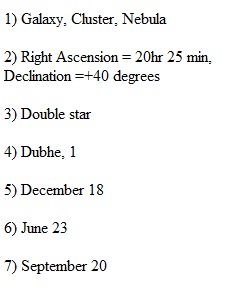


Q Solar System motions and the SC001 and SC002 Star Charts Follow along with the Helpful videos for Third hour C You can download a word version if you like: Third hour C exercise Actions Use the SC001 and SC002 star charts to answer the following questions. To turn in your answers for grading, hit the "Submit Assignment" Button in the top right and then submit all the work as text or as a file upload. Make sure to number each answer. Questions Review 1. Other than stars and constellations, name three other types of celestial objects plotted on the charts? 2. Find the star marked by the Greek letter ? in the constellation Cygnus (Hint: it is on the SC001 chart). What is its Right Ascension coordinate? What is its Declination coordinate? (Specify Right Ascension first, to demonstrate you know which coordinate is which.) 3. Locate the star at the following coordinates: Right Ascension = 5h 15 min, Declination = -8.0 degrees. What type of star is it? 4. Locate the star at the following coordinates: Right Ascension = 11h 5 min, Declination = +62.0 degrees. What is its name, and what is its magnitude? Motions of the Sun 5. Approximately what date (month and day) is the Sun (which is on the ecliptic), furthest south from the celestial equator? 6. Approximately what date (month and day) is the Sun (which is on the ecliptic), furthest north from the celestial equator? 7. On what date (month and day) is the Sun (which is on the ecliptic), crossing through the celestial equator but heading southwards? 8. On what date (month and day) is the Sun (which is on the ecliptic), crossing through the celestial equator but heading northwards? 9. In alphabetical order, four important days of the year are "autumnal equinox", "summer solstice", "vernal equinox", "winter solstice." Which of these dates is happening in the situation described in Question 5? 10. On what date would the bright star Vega be on the meridian at noon? Positions and motions of other objects 11. What is the ecliptic degree-measure ("ecliptic longitude") for the Sun on February 20? 12. If the Moon were in a First Quarter phase, and therefore 90 degrees to the east from the Sun in the sky (towards the left on the SC001 charts), and the date was February 20, what constellation would the Moon occupy? 13. If Mars was going retrograde (and is therefore in opposition from the Sun), and the date was February 1, what constellation would Mars be in? Precession 14. According to the SC002 chart, in what year will the North Celestial Pole be the furthest in the sky, from its current location? 15. Using 2000 as our current year (this is very approximate), based upon your result in Question #14, approximately how many years long is the precessional period? Cutting/pasting the following may help you when you are submitting your answers. 1) 2) 3) 4) 5) 6) 7) 8) 9) 10) 11) 12) 13) 14) 15) PreviousNext
View Related Questions